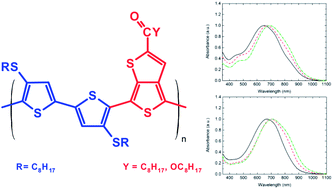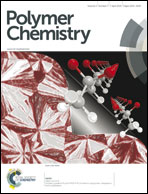Low band gap polymers for application in solar cells: synthesis and characterization of thienothiophene–thiophene copolymers†
Abstract
In this paper we present the synthesis and characterization of two novel copolymers obtained from a bithiophene unit carrying octylsulfanyl side chains and thienothiophene units substituted with keto (PK) or ester (PE) groups. Their structural, electrochemical and photophysical properties were investigated by gel permeation chromatography (GPC), thermogravimetric analysis (TGA), NMR, UV-visible-NIR spectroscopy, cyclic voltammetry (CV) and atomic force microscopy (AFM). They possess good solubility in common organic solvents, filmability, proneness to form π-stacks, moderate solvatochromism, good thermal stability and low band gap energy. They were tested as donor materials in combination with [70]PCBM (electron acceptor) in bulk-heterojunction polymer solar cells. The geometry of the devices is: glass/ITO/PEDOT:PSS/copolymer:[70]PCBM/Ca/Al. The external quantum efficiency curve of the best device, realized using a blend of PK : [70]PCBM, 1 : 2 weight ratio, shows a broad response from 350 to 1000 nm. The power conversion efficiency under 100 mW cm−2 AM 1.5G illumination is greater than 1%.


 Please wait while we load your content...
Please wait while we load your content...